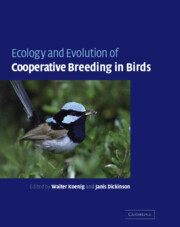Book contents
- Frontmatter
- Contents
- List of contributors
- Introduction
- 1 Evolutionary origins
- 2 Delayed dispersal
- 3 Fitness consequences of helping
- 4 Parental care, load-lightening, and costs
- 5 Mating systems and sexual conflict
- 6 Sex-ratio manipulation
- 7 Physiological ecology
- 8 Endocrinology
- 9 Incest and incest avoidance
- 10 Reproductive skew
- 11 Joint laying systems
- 12 Conservation biology
- 13 Mammals: comparisons and contrasts
- 14 Summary
- Names of bird and mammal species mentioned in the text
- References
- Taxonomic index
- Subject index
13 - Mammals: comparisons and contrasts
Published online by Cambridge University Press: 02 December 2009
- Frontmatter
- Contents
- List of contributors
- Introduction
- 1 Evolutionary origins
- 2 Delayed dispersal
- 3 Fitness consequences of helping
- 4 Parental care, load-lightening, and costs
- 5 Mating systems and sexual conflict
- 6 Sex-ratio manipulation
- 7 Physiological ecology
- 8 Endocrinology
- 9 Incest and incest avoidance
- 10 Reproductive skew
- 11 Joint laying systems
- 12 Conservation biology
- 13 Mammals: comparisons and contrasts
- 14 Summary
- Names of bird and mammal species mentioned in the text
- References
- Taxonomic index
- Subject index
Summary
Working on birds has two major logistical advantages over mammals: their observation need not rely on habituation, and they can be individually marked more easily. It is therefore not surprising that despite the studies summarized in Solomon and French (1997), work on cooperative breeding in vertebrates has been markedly bird-biased (Emlen 1991), with the result that theory on the evolution of cooperative breeding has been primarily developed for birds (Chapters 1 and 3). Such theory has addressed three questions: (1) Why do individuals delay dispersal? (2) Why do they delay breeding? (3) Why do they help? The answers to these questions do not form a linear progression of results that will lead us to understand the evolution of cooperative breeding, for both birds and mammals may be cooperative without delaying either dispersal or breeding, and may be non-cooperative whilst delaying both. Nevertheless, these questions remain a useful framework for understanding cooperative breeding in the majority of cases (Emlen 1995), and will form the structure of this chapter.
DEFINITIONS AND TERMINOLOGY
Cooperative breeding arises when three or more individuals cooperate to provide care to offspring, and hence some individuals inevitably care for offspring that are not their own. Following Cockburn (1998), I encompass a broad number of circumstances in which individuals may knowingly provide care to others, including when individuals have not bred (helpers-at-the-nest) as well as when they have bred (plural, communal, cooperative polygamous systems).
In birds, cooperative species are usually characterized by individuals incubating and/or feeding non-descendant offspring.
- Type
- Chapter
- Information
- Ecology and Evolution of Cooperative Breeding in Birds , pp. 210 - 227Publisher: Cambridge University PressPrint publication year: 2004
- 82
- Cited by

